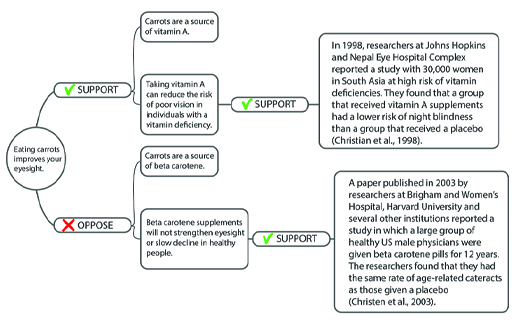4 From maps to words
In Section 2, you reached the point where your argument map is sufficiently developed to make the next step: writing a discussion on the main claim that ends with a reasoned conclusion.
Here is a recipe that can help you with this step.
Recipe: from maps to words
How to turn an argument map into a discussion with a reasoned conclusion.
1 Start your text by describing the main claim. You may want to add a sentence explaining why you are examining this claim. For instance, the claim that ‘Eating carrots is good for your eyesight’ is a common one, but is it true?
2 Next look at the supporting claims. Describe these in a paragraph or so. Conclude with the concrete evidence for these claims. You may want to start the paragraph by stating explicitly what you’re going to do in this paragraph. For instance, ‘Let’s start by examining the evidence in favour of this claim.’
3 Then look at the opposing claims. Again, describe the claims and conclude with the concrete evidence. To indicate that you are now switching from supporting to opposing claims, you may want to use a connecting phrase, such as ‘However’, ‘But’, ‘Though’, etc.
4 Finally, you need to weigh up the opposing and supporting claims and draw a general conclusion. You may again want to use a connecting phrase (e.g. ‘In conclusion, …’) to signpost what you are doing. Return to the main claim. Is it true or false? Or perhaps it is partly true and partly false. Summarise in which ways it is true and in which ways it is false according to the evidence.
5 If you have used references, conclude with a reference section. You can find advice on the use of references and in-text citations on the OU Library site.
Activity 3 Writing up the argument
Given the argument map that you have constructed, write a few paragraphs discussing the claim that ‘Eating carrots improves your eyesight’. Try to follow the recipe above.
Discussion
Here is our attempt. Next to our text are the steps of the recipe, so you can see exactly what has been done in each paragraph. Also any connecting phrases and sentences that signpost what is being done in the discussion are underlined.
You may remember being told as a child that eating carrots is good for your eyesight, but is it?
| 1. Start your text by describing the main claim. You may want to add a sentence explaining why you are examining this claim. |
Let’s start by examining the evidence in favour of this claim. Carrots are a source of vitamin A. Vitamin A has indeed been shown to reduce the risk of poor vision in individuals who are likely to have a vitamin deficiency. More specifically, researchers at Johns Hopkins and Nepal Eye Hospital Complex found that vitamin A supplements can reduce the risk of night blindness in Asian women at high risk of vitamin deficiencies (Christian et al., 1998). | 2. Next look at the supporting claims. Describe these in a paragraph or so. Conclude with the concrete evidence for these claims. You may want to start the paragraph by stating explicitly what you are going to do in this paragraph, for instance: ‘Let’s start by examining the evidence in favour of this claim.’ |
However, the study looked only at people who had a high risk of vitamin deficiencies. What about healthy individuals? Researchers at Brigham and Women’s Hospital, Harvard University and other institutions found that male participants (from the US) had the same rate of cataracts, regardless of whether they were given beta carotene or a placebo (Christen et al., 2003). | 3. Then look at the opposing claims. Again, describe the claims and conclude with the concrete evidence. To indicate that you are now switching from supporting to opposing claims, you may want to use a connecting phrase, such as ‘However’, ‘But’, ‘Though’, etc. |
In conclusion, eating carrots can be good for you, if you are likely to have a vitamin deficiency. However, if you are on a healthy diet already, eating extra carrots is not going to make a difference. | 4. Finally, you need to weigh up the opposing and supporting claims and draw a general conclusion. You may again want to use a connecting phrase (e.g. ‘In conclusion, …’) to signpost what you are doing. Return to the main claim. Is true or false. Or perhaps it is partly true and partly false. Summarise in what ways it is true and in what ways it false according to the evidence. |
References Christen, W. G., Manson, J. E., Glynn, R. J., Gaziano, J. M., Sperduto, R. D., Buring, J. E., Hennekens, C. H. (2003) ‘A Randomized Trial of Beta Carotene and Age-Related Cataract in US Physicians’, Arch Ophthalmol., 121(3), pp. 372–378. Christian, P., West Jr., K. P, Khatry, S. K., Katz, J., LeClerq, S., Pradhan, E. K., Shrestha, S. R. (1998) ‘Vitamin A or β-Carotene Supplementation Reduces but Does Not Eliminate Maternal Night Blindness in Nepal’, J. Nutr., 128(9), pp. 1458–1463. | 5. If you have used references, conclude with a reference section. |
Undoubtedly there will be differences between the wording of your and our discussion. However, if you followed the recipe, the overall structure of your discussion should be similar to ours.
The text in Activity 3 is certainly not an example of high literature. It may even feel a bit stilted. However, it will do the job in an academic context (for example, in answer to an assessment question). It will also work in professional contexts.
Of course, the recipe provided shows only one possible way to go from an argument map to a text. For comparison, here is a text by a reporter for the New York Times, Anahad O’Connor (2005). It covers mostly the same ground as our text, but the content has been organised a little differently. In the right-hand margin are some comments which relate the text to our argument map. Also, as before, connecting phrases and sentences have been highlighted which signpost the structure of the article and the argument.
THE CLAIM – Eating carrots improves your eyesight. | The main claim is set out at the beginning, as in our text. |
THE FACTS – Your mother probably told you that carrots are good for your eyes – and you probably dismissed it as just an old wives’ tale. But the claim is not baseless. | This is followed by a sentence that tells us why the claim is of interest. |
Carrots are high in beta-carotene, a component of vitamin A, which is critical to normal vision. It’s no coincidence that in countries where rice is a dietary staple but carrots and other sources of the vitamin are scarce, poor vision is rampant. | The context is set. The relationship between carrots and beta-carotene is introduced. The rest of this paragraph is not covered by our argument map. |
So should you forget about glasses and just eat carrots? Probably not. Studies show that while taking vitamin A can reverse poor vision caused by a deficiency, it will not strengthen eyesight or slow decline in people who are healthy. | Interestingly, the author introduces the opposing and supporting claims in one single sentence. They are contrasted using the connecting word ‘while’. |
A study by researchers at Johns Hopkins in 1998, for example, looked at 30,000 women in South Asia at high risk of vitamin deficiencies. It found that a group that received vitamin A tablets had 67 per cent fewer cases of night blindness than a group that received a placebo. | Next, the author reveals evidence for the supporting claim. |
But in 2003, researchers at Brigham and Women’s Hospital in Boston found that a group of thousands of healthy men who took beta carotene pills for 12 years had the same rate of age-related cataracts as those given a placebo. | In this paragraph, the evidence for the opposing claim is dealt with. |
| THE BOTTOM LINE – Eating carrots helps maintain normal vision. | The conclusion has no explicit justification – it is left to the reader to make the connection with the claims and evidence from the preceding paragraphs. |
Hopefully this illustrates that, although the recipe this author used is different in detail from ours, the strategy is on the whole very similar. The author deals systematically with the claims and evidence and uses connecting phrases to signal to the reader what they are doing.

